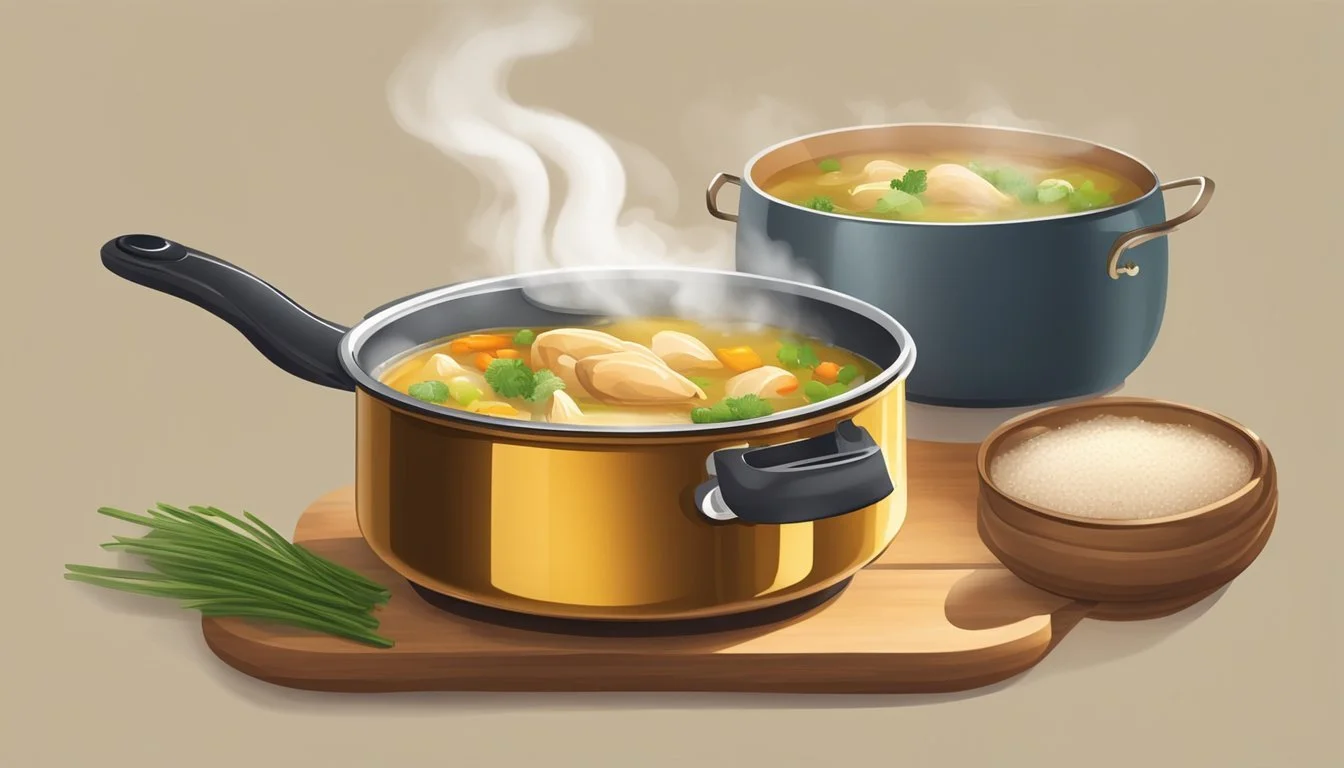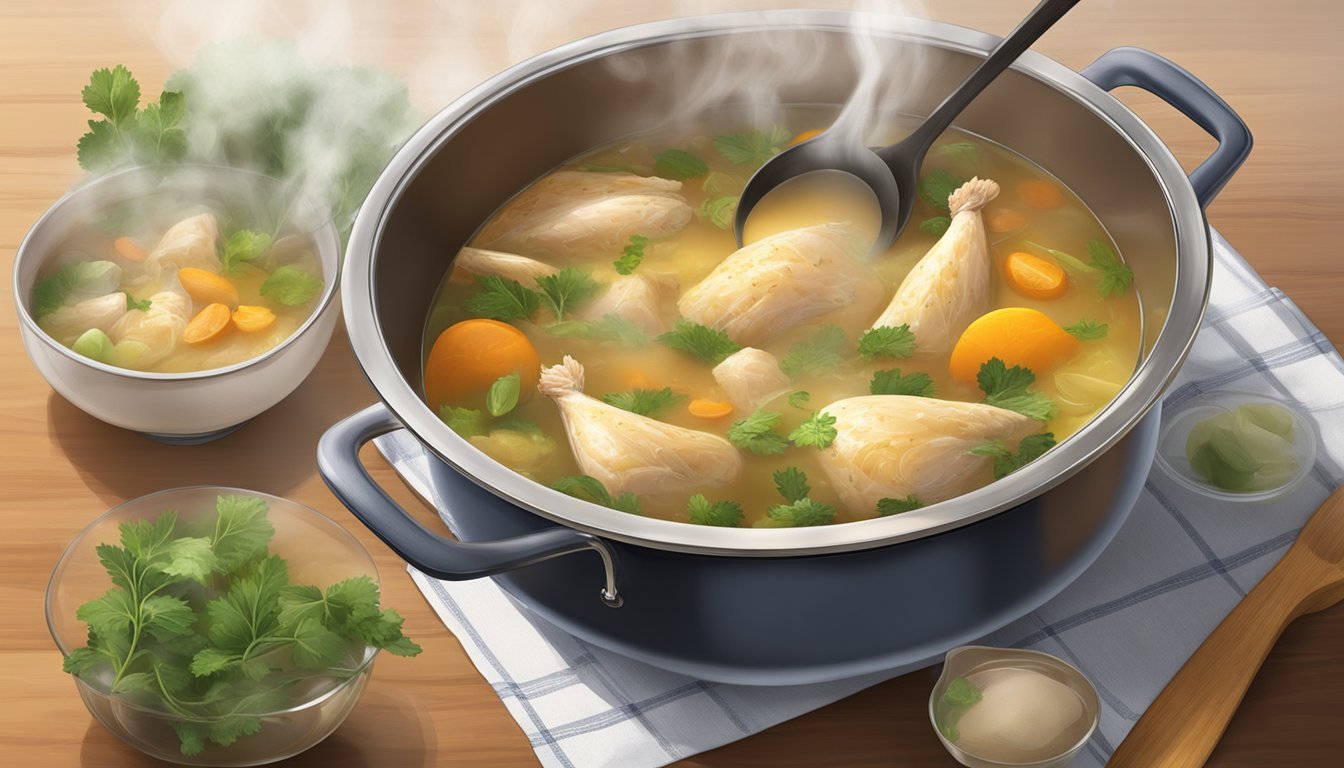Best Way to Reheat Chicken Soup
Ensuring Hearty Flavor in Every Bowl
Reheating chicken soup properly is key to preserving its heartiness and rich flavor. Chicken soup, with its melding of tender meat, vegetables, and warming broth, can lose its appeal if not heated with care. The goal is to evenly warm the soup to a safe temperature without compromising the delicate balance between its ingredients. Achieving this preserves not only the taste but also the comfort that comes with a bowl of homemade chicken soup.
When it comes to texture, special attention is needed. The noodles, if left in the soup when reheated, can become soggy, and the vegetables may lose their crunch. It is important to reheat the soup in a way that maintains the integrity of these components. The methods of reheating also play a role in flavor retention, ensuring that the aromatic qualities do not dissipate with the steam.
The task of reheating chicken soup should not be taken lightly. It's not just about warming a dish; it's about revitalizing a meal so that it provides the same nourishing experience as when it was first prepared. Whether using a stovetop, microwave, or oven, there are efficient ways to bring chicken soup back to life, ensuring the soup is heated through and through while keeping its flavor and texture as close to the original as possible.
Understanding Chicken Soup Composition
When reheating chicken soup, it's imperative to consider its components, the variety of flavor profiles, and the texture of ingredients like noodles and vegetables.
Soup Components
Chicken soup typically comprises a broth enriched with chicken pieces, a mixture of vegetables, and often includes grains or egg noodles. Each element plays a critical role in the soup's overall heartiness.
Chicken: Adds protein and depth of flavor. It’s important to ensure that chicken is thoroughly reheated to a safe temperature.
Vegetables: Commonly carrots, celery, and onions, which should retain their slight crunch and nutritional value upon reheating.
Grains/Noodles: Often rice or varieties of pasta like egg noodles, which can become mushy if overcooked during reheating.
Broth: The liquid base that carries the essence and flavors of the soup.
Flavor Profiles
The flavor profile of chicken soup is a symphony of the savory taste of chicken, the sweetness of vegetables, and the earthiness of herbs. Seasonings such as salt and pepper are basic, but other ingredients like lime juice can enhance the zest and complement the chicken's flavors.
Herbs and Spices: Typically bay leaves, thyme, or rosemary.
Acidity: A splash of lime juice gives a fresh brightness that can revive the flavors, especially in leftovers.
Texture Considerations
The texture is a key aspect to consider, particularly with leftovers that may have been refrigerated or frozen. Reheating should restore the soup to its original state as much as possible.
Noodles: To prevent egg noodles from becoming mushy, avoid overheating them.
Vegetables: Should retain some of their firmness; overcooking can lead to a loss of texture.
Chicken: Aim for chicken pieces that are moist and tender, not dry or tough.
Storage Techniques for Chicken Soup
Proper storage of chicken soup is critical to preserving its heartiness and flavor. Below are essential tips for refrigerating, freezing, and thawing chicken soup, ensuring it remains delicious and safe for consumption.
Refrigeration
Chicken soup should be placed in the refrigerator within two hours of cooking to prevent bacterial growth. To maximize freshness and extend shelf life, one should:
Use airtight containers to store the soup, which can keep for about three to five days.
Portion the soup into smaller containers to speed up cooling and to make reheating more convenient.
Freezing
For longer storage, freezing is an excellent option. When freezing chicken noodle soup, follow these guidelines:
Allow the soup to cool completely before freezing to preserve its texture and prevent the growth of bacteria.
Store soup in airtight containers or heavy-duty freezer bags, leaving some space at the top as liquids expand when frozen.
Properly stored, frozen soup can last for up to four to six months, minimizing the risk of freezer burn.
Thawing Tips
When it's time to thaw frozen soup, safety and taste should be your primary considerations:
Thaw the soup in the refrigerator overnight, maintaining a safe temperature to prevent bacterial growth.
If pressed for time, one can use a microwave to defrost the soup, ensuring to stir periodically for even thawing.
Avoid refreezing previously thawed soup to maintain its quality and flavor.
Safety Measures in Soup Reheating
Ensuring the safety of reheated chicken soup is paramount to avoid bacteria growth and food poisoning. Accurately monitoring the temperature during reheating and following recommended procedures can maintain both the flavor and the safety of the soup.
Preventing Bacteria Growth
To prevent bacteria from proliferating in leftover soup, it should be cooled down and refrigerated promptly. Bacteria thrive between 40°F and 140°F, known as the "danger zone." Soup should not be left at room temperature for more than two hours. If the room is exceptionally warm (above 90°F), the time is reduced to one hour.
Monitoring Temperature
When reheating soup, it's crucial to reach and maintain an internal temperature of 165°F for at least one minute. A food thermometer should be used to ensure accuracy. This optimal temperature ensures that any potential harmful bacteria are completely destroyed.
Reheating Leftover Soup
Reheating leftover soup should be done until steaming hot throughout, even if the soup will be consumed later. When using a microwave, soup should be reheated in short intervals, stirring occasionally to distribute heat evenly. For stovetop reheating, a gentle and consistent heat will help maintain the integrity of the soup, preventing overcooking or scalding.
Reheating Methods Overview
The reader should ensure they use the correct reheating method to maintain the heartiness and flavor of chicken soup. The microwave offers a quick solution, while the stovetop provides a gentler approach. Alternative heating methods offer convenience for varying needs.
Microwave Method
Utilizing a microwave to reheat chicken soup is a quick option. One should place the soup in a microwave-safe bowl and cover it with a microwave-safe lid to prevent splattering. It's important to stir occasionally to promote even heating. The typical process involves heating for one minute, stirring, then continuing to heat in 30-second intervals until the desired temperature is reached.
Stovetop Technique
The stovetop reheating method is preferred for a gentle, even warming. Pour the soup into a saucepan and reheat it over a gentle simmer, stirring periodically. This technique allows for flavors to meld together nicely and prevents the noodles from becoming overly soft.
Alternative Heating Methods
Other reheating methods include using an oven or slow cooker for a slow, even heat distribution, or a pressure cooker for a faster yet controlled reheating cycle. The oven method is suitable for larger quantities - one covers the soup with foil and reheats it at a moderate temperature, typically for about 20-30 minutes. For the slow cooker, setting the temperature to low allows gradual reheating without vigorous boiling that can break down ingredients. The pressure cooker can be set to a low reheating function if available.
Step-by-Step Reheating Instructions
Reheating chicken soup properly ensures that it retains its flavor and texture. The following methods provide reliable techniques for warming up your soup while maintaining its heartiness.
On the Stovetop
The stovetop method allows for gradual and even heating. One begins by placing the soup into a pot suited for the volume of liquid. The soup should be reheated over medium heat. As it warms, one needs to stir occasionally to promote even heating and prevent burning. Once the soup reaches a simmer, they should check that the chicken has been heated to a safe internal temperature of 165 degrees Fahrenheit before serving.
Pour chicken soup into a pot.
Heat medium, stirring occasionally.
Simmer, then serve hot.
Using the Microwave
Microwaving is a quick and convenient method to reheat chicken soup. The user should transfer the soup into a microwave-safe bowl, covering it with a microwave-safe lid or plastic wrap. This cover should have a vent to allow steam to escape, serving as a splatter guard. Heating should be done in short intervals, such as 1-2 minutes on a medium setting, with stirring in-between to ensure even temperature distribution. Once the soup is steaming hot, it's ready to serve.
Transfer to microwave-safe bowl.
Cover with vented lid or plastic wrap.
Heat at medium, in short intervals, stir well.
Oven Reheating Technique
Oven reheating is less common but useful for large quantities. The soup should be placed in an oven-safe dish and covered with a layer of aluminum foil to keep the moisture in. The oven should be preheated to a moderate temperature, around 350 degrees Fahrenheit. The soup needs consistent heating for a duration that varies depending on the quantity. This method heats the soup gently, reducing the risk of drying out the ingredients.
Place soup in oven-safe dish, cover with aluminum foil.
Preheat oven to 350°F.
Reheat until hot throughout.
Enhancing Flavor and Texture After Reheating
After reheating chicken soup, one might find the flavors muted and the texture changed. The following methods help in reviving the soup's heartiness and enriching its flavor to make it as enjoyable as when it was first prepared.
Adding Fresh Ingredients
Incorporating fresh ingredients into reheated chicken soup can significantly boost its flavor profile. One may consider:
Vegetables: Briefly sauté vegetables such as carrots, celery, or bell peppers and add them to the soup to enhance its freshness.
Herbs: Stirring in fresh herbs like parsley or dill can add a new dimension to a previously flat flavor.
Adjusting Consistency
The consistency of the soup often changes upon reheating, especially in cream-based or noodle-laden varieties. Adjustments may include:
Noodles: If the chicken noodle soup has absorbed much of the broth, adding freshly cooked noodles can restore balance.
Thickening: For a thinned cream-based soup, a roux (equal parts flour and fat cooked together) can be whisked in to thicken it to the desired level.
Final Touches
A few finishing touches can elevate the reheated soup and make it more appealing. These touches include:
Cream-Based Soups: (What wine goes well with soups?) A swirl of cream or a dollop of sour cream can be added after heating to reintroduce richness.
Crusty Bread: Serving with a side of crusty bread enhances the overall dining experience, offering textural contrast and a way to sop up every last drop.
Best Practices for Chicken Soup Reheating
Reheating chicken soup requires careful attention to maintain its heartiness and flavor. Selecting the right portion size and reheating method is essential in preserving the soup's quality.
Portioning Out Soup
A key to preserving the homemade chicken soup's quality during reheating is to heat only the amount that will be consumed immediately. It is advisable to:
Store leftovers in multiple small containers rather than a single large one.
Choose glass or ceramic containers as they reheat more evenly and are generally safer than plastic, which can release chemicals under heat.
Ensure leftovers are cooled down before refrigeration to prevent condensation that can make the soup too watery.
Avoiding Common Mistakes
When reheating, it's crucial to avoid common mistakes to keep the soup's integrity.
Avoid overheating, which can break down noodles into a mushy texture and can also cause dairy-based soups to separate.
Stir the soup occasionally, ensuring an even distribution of heat.
If using a microwave, set the power level to medium and reheat in short intervals, stirring in between to prevent hotspots and overcooking.
Serving Recommendations
The final step of the reheating process greatly affects how a bowl of soup is perceived when served.
Always serve hot, but not boiling, to preserve the texture and flavors, especially with delicate ingredients like herbs.
For homemade chicken noodle soup, consider adding fresh noodles while reheating to keep them from becoming overly soft.
Garnish with fresh herbs or a light drizzle of a quality oil right before serving to refresh the taste.





